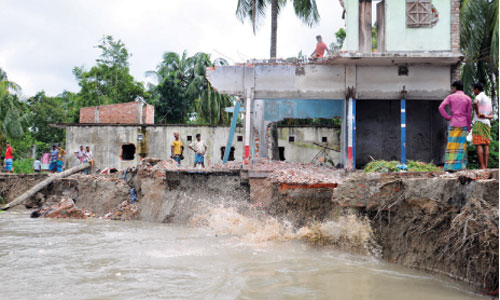Receding floods leave behind acute Aman seedling crisis
Growers have started raising their aman rice plantation once again as floodwater receded in many districts, leaving behind an acute crisis of seedlings, officials of Department of Agricultural Extension have said.
The recent floods, caused by onrush of upstream water, have affected at least 1,22,000 hectares of croplands, mostly aman rice and its seedbeds, in 23 districts, they say.
The floods also caused heavy losses to fish farmers washing away fish farms and damaged homesteads of thousands of people.
Meanwhile, as the floodwater receded, the number of patients and death tolls due to floods continued to rise.
Farmers Ashraful Islam and Mohammad Babu at Nageshwari Upazila in Kurigram have said that they are re-planting aman seedlings as floodwater, which receded, damaged their previous seedling plantation.
They were collecting the seedlings from high lands which were about eight kilometers away at higher prices.
DAE deputy director for monitoring Mohammad Abduhu told New Age on Friday that the farmers were raising their aman rice plantation as floodwaters receded.
The farmers would be raising aman as the late variety of aman plantation would continue until September, he said.
The ministry of agriculture is considering positively granting incentives for the flood-affected growers, the DAE official said.
According to the national health crisis management centre of the Directorate of Health Services said that more than 16,000 patients with various water-borne diseases have so far been admitted to health complexes in the flood-affected districts.
Death toll due to floods increased to 117 in 19 districts on Friday, officials have said.
Of the deaths, 106, mostly of minors, were from drowning while another 11 people died of snake bites, they told New Age on Friday.

People rush to get relief goods when a voluntary team nears a flood affected village at Baghaduba Union of Bakshiganj Upazila in Jamalpur on Friday. — Focusbangla photo
The Brahmaputra-Jamuna, the Padma and the Surma-Kushiyara river systems are in falling trend while the Ganges basin is in rising trend.
Flood forecasting and warning center said on the day that overall flood situation would continue to improve in the next 72 hours from Friday morning as the Brahmaputra-Jamuna, the Padma and Surma-Kushiyara rivers might continue to fall.
New Age correspondent in Kurigram has reported that l flood situation improved in all the nine upazilas in the district and the affected people are now busy repairing their damaged houses.
However, the farmers who lost their seedling of ropa aman in the floods, have started re-plantation of aman by purchasing the seedlings from high lands at higher rates.
Meanwhile, receding flood water has caused severe river erosion in some parts of the district rendering a good number of people homeless and landless.
New Age correspondent in Manikganj has said that ferry services on Paturia-Daulatdia route resumed on Friday after seven days into disruption.
The ferry service on the route became normal after making usable three of the four landing stations, said Shofiqul Islam, manager (commerce) of Bangladesh Inland Water Transport Corporation at Aricha office.
They could not start working to repair the fourth landing station due to strong current, he said.
The BIWTA suspended the ferry service on August 6 as three landing stations of the Daulatdia ferry terminal under Goalunda in Rajbari were damaged by the strong current by the River Padma.
News Courtesy: www.newagebd.net











